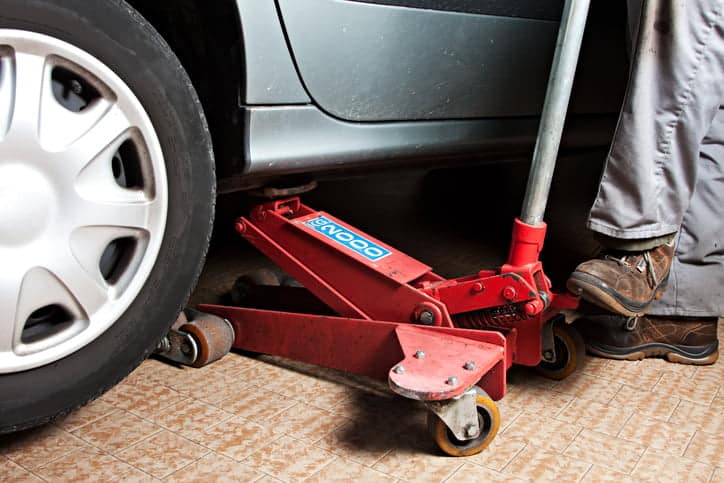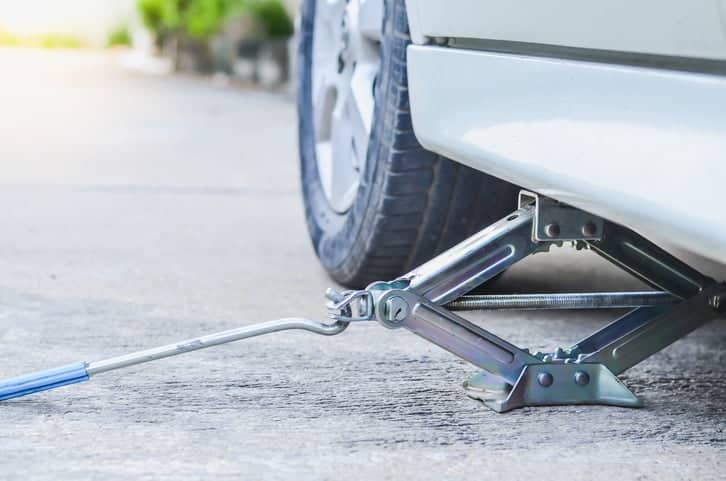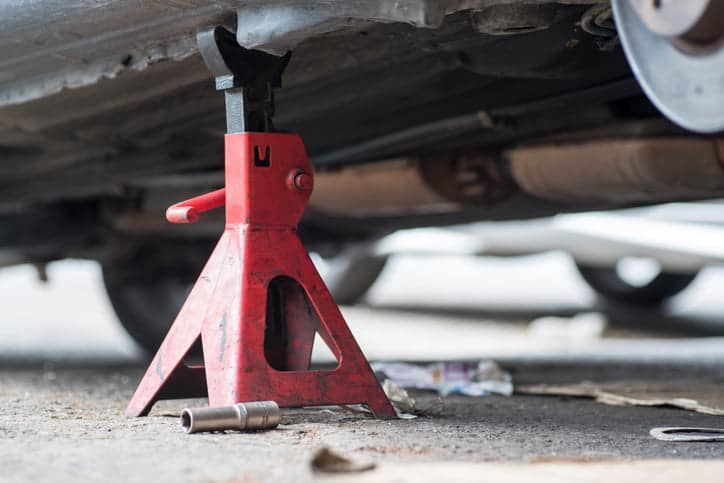Got a project that you need a jack for, like changing a tyre or checking your exhaust? We’ve got the information you need on how to choose the right one and how to use it safely.
Blog Sign Up
"*" indicates required fields
Which Car Jack Should I Use?
There are two main types of car jacks that you can choose to use on your car at home: scissor jacks and floor jacks. While they both do the same thing (lift your car up) they’re slightly different so it’s best to think about how you’ll be using it to decide which one you want.
Let’s take a closer look at these two car jacks below.
Floor Jacks:
Floor jacks are the most widely used car jack and give you stability with heavy loads. They normally have four wheels so you can move it, as well as a long handle that lets the operator pump the hydraulic lift to get the car off the ground.
Floor jacks are useful if you regularly work on your car in a home garage, and are also great for lifting cars on to jack stands (which we’ll get to later). Make sure you choose a jack that’s been approved to lift the weight of your vehicle.
Scissor Jacks:
Scissor jacks are small and portable, so they’re better if you’re looking for something to carry in your boot for roadside repairs. In fact, some car manufacturers supply a scissor jack with a spare wheel, so you might have one anyway.
You can buy scissor jacks that work with any car, but most of them are built especially for a particular make or model. That’s because you need to use them on specific lifting points on the car, which you can find in your owner’s manual.
Unlike floor jacks which use a hydraulic pump, scissor jacks use a simple screw mechanism to provide the lifting power. This is what makes them so small, lightweight and portable.
The jack you choose will depend on what kind of maintenance and repairs you normally carry out on your car. If you do a lot of your own maintenance work, like changing the oil filter and brake pads, we’d recommend a floor jack. If you’ll be using it for changing the wheels in an emergency, a scissor jack is an affordable choice that’s portable and easy to use.
How to Use a Car Jack
Car jacks are easy to use once you know the basics. Here, we tell you how to use both floor and scissor jacks to lift your car safely, and how to put your car on to jack stands.
For both jack types, always make sure your car is in first gear with the handbrake on to prevent the car rolling. You can also use chocks to stop the wheels from moving, but they’re not always necessary.
Using a Floor Jack:
- Before you start jacking up your car, you need to find out where its safe lift points are – these are the strongest parts of the vehicle’s chassis (normally just in front or behind the wheel arches). You can usually find the exact points in your owner’s manual.
- Manoeuvre the jack under the lift points of the car, so that the base plate is directly beneath the sill of the frame.
- Begin lifting the jack by pumping the height adjustment arm. Go slowly when the base plate approaches the car so that you can align it properly and make sure that the weight is evenly distributed.
- Continue to pump the height adjustment arm until the car is raised off the ground. Most floor jacks also have a locking mechanism which will keep the arm in place so that you can move around underneath the car safely.
- When you’re ready to lower your car, move the height adjustment arm to its vertical position and twist it. This releases the air in the pump, lowering the car slowly to the ground.
Using a Scissor Jack:
- It’s crucial that you use a scissor jack directly on the car’s safe lift points, so make sure you know exactly where these are located. Often, scissor jacks can only be used at specific points on the chassis, with a specially made base plate that fits into grooves on the car’s undercarriage.
- Scissor jacks normally come in two parts: the jack itself and a handle which you have to attach before you use it. Once the jack is in place, slide the handle on and begin turning in the direction marked ‘R’ (raise). Remember to go slowly as the jack approaches the car’s undercarriage to make everything is properly aligned.
- Once the car is fully raised, we’d recommend that you remove the handle so you don’t trip over it, and also to prevent it from getting knocked.
- To lower the car, simply crank the turning handle in the opposite direction – often marked ‘L’ (lower) – until all four wheels are safely back on the ground.
Using Jack Stands:
Jack stands are handy if you’re working under your car for long periods and need extra stability. It’s also a good idea to you use jack stands if you’re storing a classic car, as raising the car off the ground will prevent the tyres becoming warped.
Here’s how to jack your car up on to a set of jack stands.
- Find the safe lift point at the front of your car and follow the steps above to safely lift the front section of the car.
- Once the front two wheels are fully off the ground, place two jack stands at the safe lift points on each side of the car. Then, slowly lower the jack so that the two jack stands take the weight of the front section of the car.
- From here, it’s simply a case of repeating the steps above to lift the rear of the car on to jack stands, too, so that all four wheels are completely off the ground and the car’s weight is supported by all four jack stands.
- When you want to lower the car back down, raise the car higher at one end with the jack and remove the stands. Then, do the same for the other side, lowering the car slowly back on to its wheels.
Essential Jack Safety Advice
Jacking up a car can be dangerous, so make sure you take your time, use the right equipment and find your car’s safe lifting points. Here are some extra safety tips:
- Always make sure the car is in first gear with the handbrake on. This limits the risk of rolling.
- If you don’t have your owner’s manual, head online to try and figure out where the safe lift points are. Never jack your car if you aren’t sure where it’s safe to lift.
- Make sure the jack and jack stands you choose are suitable for the weight of your car.
- Only ever use a jack on a flat, level and hard surface.
- If you’re working under the vehicle, always use jack stands. A jack is only good for holding a car while you’re changing the wheel, not for when you’re actually under the car.
From flat tyres to non-starting engines, Holts develop car repair products that are designed to get you back on the road when the worst should happen. For more information or to browse our complete product range, visit our homepage today.



